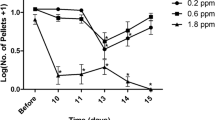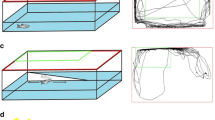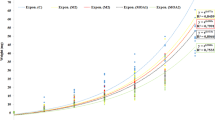Abstract
Glyphosate is a broad spectrum herbicide used primarily in agricultural applications for the control of variety of weeds in both terrestrial and aquatic environments. Pollution of aquatic habitat may result in mass fish mortality or affect the physiology and survival of fish. Thus, this study evaluated the effects of exposure of juveniles of the African catfish, Clarias gariepinus, to sub-lethal doses of glyphosate, to determine its effects on the behaviour and growth response. Eight fish samples were introduced into individual plastic tank containing 0.00 ml (control), 2 ml/L (Treatment 1), 4 ml/L (Treatment 2), 6 ml/L (Treatment 3) and 8 ml/L (Treatment 4) of glyphosate in triplicate for 28 days. The physico-chemical parameters of water were within the permissive limits for aquaculture. However, the presence of herbicides in the water threatened the fish’s survival, which had detrimental impacts on the experimental fish that could be seen. According to this study, fish exposed to glyphosate displayed a variety of abnormal behaviors, including erratic swimming, loss of equilibrium, restlessness, respiratory distress, paleness/bleaching of the skin, and gasping for oxygen. In contrast, fish samples in the control group did not exhibit any discernible behavioral changes. Also, the weight of exposed fish did not increase significantly (P < 0.05) with period of exposure. This study concluded that glyphosate is highly toxic to Clarias gariepinus (because of the erratic behaviours and mortality that was directly proportional to concentration and exposure duration). Therefore, indiscriminate application of glyphosate (as well as other herbicides) should be totally discouraged.




Similar content being viewed by others
Data Availability
All data generated or analysed during this study are included in this article.
References
Abdul-Farah M, Ateeq B, Ali MN (2004) Studies on lethal concentrations and toxicity stress of some xenobiotics on aquatic organisms. Chemosphere 55:257–265
Adesina SA, Ajibare AO, Ebimowei OG (2020) Growth performance and feed Utilisation in Clarias Gariepinus Fingerlings Fed graded levels of Melon (Citrillus Lanatus) seed Peel Meal-supplemented diets. Ife J Sci 22(3):001–010
Akinsorotan AM, Ajisodun AF, Izah SC, Jimoh JO (2019) Acute toxicity of paraquat dichloride on Finfgerlings of Oreochromis niloticus. Int J Res Stud Biosci 7(1):29–35
Ali S, Muhammad KI (2016) Acute toxicity of herbicide (glyphosate) in Clarias gariepinus juveniles. Toxicol Rep 3:513–515. https://doi.org/10.1016/j.toxrep.2016.05.004
APHA (American Public Health Association) (2005) Standard methods for the examination of water and wastewater, 21st edn. American Public Health Association, Washington
Ayanda OP, Oniye SJ, Anta J (2017) Behavioural and some physiological Assessment of glyphosate and paraquet toxicity on Juvenile of Africa Catfish Clarias gariepinus. Pakistan J Zool 49(1):183–190
Ayoola SO (2008) Histopathological effects of glyphosate on juvenile African catfish (Clarias gariepinus). Ameri-Surasian J Agric Environ Sci 4(3):362–367
Bagheri A, Nezami A (2000) Effect of weed control and plant densities on yield and morphological characteristics of chickpea in dry farming of north khorasan. J Agric Sci Ind Iran 14:58–67
Bathe R, Ullmann L, Sachsse K (1973) Determination of pesticide toxicity to fish. Berlin-Dahlem 37:241–246
Battaglin WA, Rice KC, Focazio MJ, Salmons S, Barry RX (2008) The occurrence of glyphosate, atrazine, and other pesticides in vernal pools and adjacent streams in Washington, D.C., Maryland, Iowa, and Wyoming, 2005–2006. Environ Monit Ass 155:281–307
Battaglin WA, Thurman EM, Kalkhoff SJ, Porter SD (2003) Herbicides and transformation products in surface waters of the Midwestern United States. J Am Water Resour Assoc 39(4):743–756
Chandra S (2008) Toxic effect of Malathion on acetylcholinesterase activity of liver, brain and gills of freshwater catfish Heteropneutes Fossilis. Environ Conserv 9:45–52
De Mel G, Pathiratne A (2005) Toxicity assessment of insecticides commonly used in rice pest management to the fry of common carp, Cyprinus carpio, a food fish culturable in rice fields. J Appl Icthyol 21:146–150
Erhunmwunse NO, Ogbeide OS, Tongo I, Enuneku AA, Adebayo PO (2018) Acute toxicity of glyphosate-based isopropylamine formulation to juvenile African catfish (Clarias gariepinus). Nigerian J Basic Appl Sci 26(2):97–101. https://doi.org/10.4314/njbas.v26i2.14
Fafioye OO, Fagade SO, Adebisi AA (2005) Toxicity of Raphia Svinifera, P. beauvruit extracts on biochemical composition of Nile Tilapia (Oreochromis niloticus). Biochemistry 17:137–142
Food and Agricultural Organization (FAO) (2007) Fishery profile – Specification of National Reporting Tables for FRA 2010. FRA Working Paper 135. Rome. Available at: https://www.fao.org/forestry/14119-1-0.pdf
Green PG, Young TM (2006) Loading of the herbicide diuron into the California water system. Environ Eng Sci 23:545–551
Hussein SY, El-Nasser MA, Ahmed SM (1996) Comparative studies on the effects of herbicide atrazine on freshwater fish Oreochromis niloticus and Chrysichthys auratus at Assiut Egypt. Bull Environ Contam Toxicol 57:503–510
Jones RJ, Kerswell AP (2003) Phytotoxicity of Photosystem II (PSII) herbicides to coral. Mar Ecol Prog Ser 261:149–159
Ladipo MK, Doherty VF, Oyebadejo SA (2011) Acute toxicity, behavioural changes and histopathological effect of Paraquat Dichloride, on tissues of Catfish (Clarias gariepinus). Int J Biool 3(2):67–74
Langiano VC, Martinez CBR (2008) Toxicity and effects of a glyphosate-based herbicide on the neotropical fish Prochilodus lineatus. Comp Biochem Physiol 147:222–231
Ma J, Bu Y, Li X (2015) Immunological and histopathological responses of the kidney of common carp (Cyprinus carpio L.) sublethally exposed to glyphosate. Environ Toxicol Pharm 39:1–8. https://doi.org/10.1016/j.etap.2014.11.004
Mhadhbi L, Boumaiza M, Beiras R (2010) A standard ecotoxicological bioassay with early life stages of the marine fish Psetta maxima. Aquat Living Res 23(2):209–216
Moreno NC, Sofia SH, Martinez CBR (2013) Genotoxic effects of the herbicide Roundup Transorbregd and its active ingredient glyphosate on the fish Prochilodus lineatus. Environ Toxic Pharm. https://doi.org/10.1016/j.etap.2013.12.012
Moura FR, Lima RR, Cunha AP, Marisco PC, Aguiar DH, Sugui MM, Sinhorin AP, Sinhorin VD (2017) Effects of glyphosate-based herbicide on Pintado Da Amazônia: Hematology, histological aspects, metabolic parameters and genotoxic potential. Envron Toxicol Pharm 56(3):241–248. https://doi.org/10.1016/j.etap.2017.09.019
Neškovic NK, Elezonic I, Karan V, Poleksic V, Budimir M (1993) Acute and sub-acute toxicity of atrazine to Carp (Cyprinus carpio). Ecotoxicol Environ Saf 25:173–182
Nwani CD, Lakra WS, Nagpure NS, Kumar R, Kushwaha B, Srivastava SK (2010) Toxicity of the Herbicide Atrazine: effects on lipid peroxidation and activities of antioxidant enzymes in the Freshwater Fish Channa Punctatus (Bloch). Int J Environ Res Public Health 7:3298–3312. https://doi.org/10.3390/ijerph7083298
Oladunjoye RY, Bankole ST, Fafioye OO, Salisu TF, Asiru RA, Olalekan OB, Solola TD (2022) Histo-morphological alteration of lethal and sub-lethal effect of glyphosate-based herbicide on catfish hybrid (heteroclarias sp.) nig. J Anim Prod 49(1):177–193
Orme S, Kegley S (2005) PAN Pesticide Database; Pesticide Action Network, North America: San Francisco, CA. http://www.pesticideinfo.org/Search_Chemicals.jsp. Accessed Jun 2005
Owolabi OD (2011) Haematological and serum biochemical profile of the upside-down catfish Synodontis Membranacea Geoffroy Saint Hilaire from Jebba Lake, Nigeria. Comp Clin Pathol 20:163–172. https://doi.org/10.1007/s00580-10-0973-x
Owolabi OD, Abdulkareem SI, Ajibare AO (2021) Haemato–biochemical and ionic regulatory responses of the hybrid catfish, Heteroclarias, to sublethal concentrations of palm oil mill effluents. Bull Natl Res Centre 45:220–232. https://doi.org/10.1186/s42269-021-00679-8
Pandey RK, Singh RN, Singh S, Singh NN, Das VK (2009) Acute toxicity bioassay of dimethoate on freshwater air breathing catfish Heteropneustus Fossilis (Bloch). J Environ Biol 30:437–440
Phyu YL, Warne M, St J, Lim RP (2006) Toxicity and bioavailability of atrazine and molinate to the freshwater fish (Melanotenia Fluviatilis) under laboratory and simulated field conditions. Sci Total Environ 356:86–99
Rahman MZ, Hossain Z, Mullah MFR, Ahmed GU (2002) Effect of Diazinon 60EC on Anabus testudineus, Channa punctatus and Barbades gomonotus. NAGA. The ICLARM Quarterly 25:8–11
Roy NM, Carneiro B (2016) Glyphosate induces neurotoxicity in zebrafish. Environ Toxicol Pharm 42:45–54. https://doi.org/10.1016/j.etap.2016.01.003
Tilak KS, Veeraiah K, Bhaskara P, Butchiram MS (2007) Toxicity studies of Butachlor to the freshwater fish Channa punctata (Bloch). J Environ Biol 28:285–487
Udume BU, Anyaele U (2022) The impact of sub-lethal concentrations of glyphosate on growth and haematology of African catfish under aquatic ecological micro-climate. Envr Chem Ecot 4:164–170. https://doi.org/10.1016/j.enceco.2022.06.001
USEPA Ecotoxicology Database (2004) [Online] Available:http://www.usepa.gov/ecotox
Warren CE (1997) Biology and water pollution. W.B. Saunders Company, Philadelphia
Wilson AGE, Thake DC, Heydens WE, Brewster DW, Hotz KJ (1996) Mode of action of thyroid formation in the male Long-Evans rat administered high doses of alachlor. Fundam Appl Toxicol 33:16–23
World Health Organization (2012) Glyphosate Environmental Health Criteria, Publication NO 159, Geneva, Switzerland
Acknowledgements
The authors acknowledge the painstaking efforts of our undergraduate students in the Department of Fisheries and Aquaculture Technology, Olusegun Agagu University of Science and Technology Okitipupa, Nigeria for doing some pilot studies on some aspects of the research work.
Funding
This study received no specific support from public, private, or non-profit funding bodies.
Author information
Authors and Affiliations
Contributions
All of the authors worked together to complete this project. AAO and APO conceptualised, designed and participated in the work. The protocol was written by AAO. The statistical analysis was carried out by AAO and APO. The study’s analyses and literature searches were handled by AAO and APO. The original draft of the manuscript was written by AAO. The final manuscript was read, corrected and approved by both authors.
Corresponding author
Ethics declarations
Ethical Statement
The authors confirm that all experiments were carried out following the approval of the appropriate ethical review committee of the Central Research Laboratory, Olusegun Agagu University of Science and Technology Okitipupa, Nigeria (reference number not applicable) and were in accordance with both the national and international safety regulations and ethical principles for animal welfare. The authors also confirm that they have followed EU standards for the protection of animals used for scientific purposes.
Animal Welfare Statement
The authors confirm that the ethical policies of the journal, as noted on the journal’s author guidelines page, have been adhered to and the appropriate ethical review committee approval of the Central Research Laboratory, Olusegun Agagu University of Science and Technology Okitipupa, Nigeria has been received. The authors confirm that they have followed EU standards for the protection of animals used for scientific purposes.
Competing Interests
The authors declare that they have no competing interests.
Additional information
Publisher’s Note
Springer Nature remains neutral with regard to jurisdictional claims in published maps and institutional affiliations.
Significance’ Statement
Fish exposed to glyphosate exhibited varying abnormal morphology and behavioural responses such as erratic swimming, loss of equilibrium, restlessness, respiratory distress, paleness/bleaching of skin and gasping for oxygen. Toxicity was concentration and time of exposure dependent, hence resulting in the deleterious effects, especially at higher concentrations. The weight of exposed fish did not increase significantly (P < 0.05) with period of exposure.
Rights and permissions
Springer Nature or its licensor (e.g. a society or other partner) holds exclusive rights to this article under a publishing agreement with the author(s) or other rightsholder(s); author self-archiving of the accepted manuscript version of this article is solely governed by the terms of such publishing agreement and applicable law.
About this article
Cite this article
Ajibare, A.O., Ayeku, P.O. Glyphosate Toxicity: Effects on the Behavioural and Growth Responses of Juvenile Clarias gariepinus. Polytechnica 7, 5 (2024). https://doi.org/10.1007/s41050-024-00046-2
Received:
Revised:
Accepted:
Published:
DOI: https://doi.org/10.1007/s41050-024-00046-2




